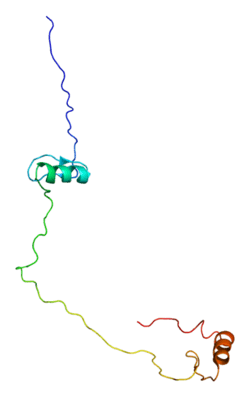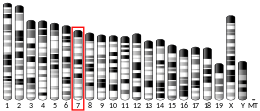TSHZ3
Teashirt homolog 3 is a protein that in humans is encoded by the TSHZ3 gene.[5] In mice, it is a necessary part of the neural circuitry that controls breathing. The gene is also a homolog of the Drosophila melanogaster teashirt gene, which encodes a zinc finger transcription factor important for development of the trunk.
Tshz3-knockout mice do not develop the respiratory rhythm generator (RRG) neural circuit, which is a pacemaker that produces an oscillating rhythm in the brainstem and controls autonomous breathing. The RRG neurons are present, but are abnormal. Those mice do not survive because they don't initiate breathing after birth. Tshz3 is being studied for its relationship to infant breathing defects in humans.[6]
TSHZ3 has been identified as a critical region for a syndrome associated with heterozygous deletions at 19q12-q13.11, which includes autism spectrum disorder (ASD) symptoms such autistic traits, speech disturbance and intellectual disability, as well as renal tract abnormalities. Mice with heterozygous Tshz3 deletion (Tshz3lacZ/+) show enrichment of ASD-related gene orthologs in the cerebral cortex, functional alterations of corticostriatal circuitry and ASD-relevant behavioral abnormalities. [7]
References
- GRCh38: Ensembl release 89: ENSG00000121297 - Ensembl, May 2017
- GRCm38: Ensembl release 89: ENSMUSG00000021217 - Ensembl, May 2017
- "Human PubMed Reference:". National Center for Biotechnology Information, U.S. National Library of Medicine.
- "Mouse PubMed Reference:". National Center for Biotechnology Information, U.S. National Library of Medicine.
- "Entrez Gene: TSHZ3 teashirt family zinc finger 3".
- Caubit X, Thoby-Brisson M, Voituron N, Filippi P, Bévengut M, Faralli H, Zanella S, Fortin G, Hilaire G, Fasano L (July 2010). "Teashirt 3 regulates development of neurons involved in both respiratory rhythm and airflow control". J. Neurosci. 30 (28): 9465–76. doi:10.1523/JNEUROSCI.1765-10.2010. PMC 6632443. PMID 20631175. Lay summary – New Scientist.
- Caubit X, Gubellini P, Andrieux J, Roubertoux PL, Metwaly M, Jacq B, Fatmi A, Had-Aissouni L, Kwan KY, Salin P, Carlier M, Liedén A, Rudd E, Shinawi M, Vincent-Delorme C, Cuisset JM, Lemaitre MP, Abderrehamane F, Duban B, Lemaitre JF, Woolf AS, Bockenhauer D, Severac D, Dubois E, Zhu Y, Sestan N, Garratt AN, Kerkerian-Le Goff L, Fasano L (November 2016). "TSHZ3 deletion causes an autism syndrome and defects in cortical projection neurons". Nat. Genet. 48 (11): 1359–69. doi:10.1038/ng.3681. PMC 5083212. PMID 27668656.
Further reading
- Olsen JV, Blagoev B, Gnad F, et al. (2006). "Global, in vivo, and site-specific phosphorylation dynamics in signaling networks". Cell. 127 (3): 635–48. doi:10.1016/j.cell.2006.09.026. PMID 17081983.
- Mehrle A, Rosenfelder H, Schupp I, et al. (2006). "The LIFEdb database in 2006". Nucleic Acids Res. 34 (Database issue): D415–8. doi:10.1093/nar/gkj139. PMC 1347501. PMID 16381901.
- Wiemann S, Arlt D, Huber W, et al. (2004). "From ORFeome to biology: a functional genomics pipeline". Genome Res. 14 (10B): 2136–44. doi:10.1101/gr.2576704. PMC 528930. PMID 15489336.
- Brandenberger R, Wei H, Zhang S, et al. (2005). "Transcriptome characterization elucidates signaling networks that control human ES cell growth and differentiation". Nat. Biotechnol. 22 (6): 707–16. doi:10.1038/nbt971. PMID 15146197.
- Strausberg RL, Feingold EA, Grouse LH, et al. (2003). "Generation and initial analysis of more than 15,000 full-length human and mouse cDNA sequences". Proc. Natl. Acad. Sci. U.S.A. 99 (26): 16899–903. doi:10.1073/pnas.242603899. PMC 139241. PMID 12477932.
- Wiemann S, Weil B, Wellenreuther R, et al. (2001). "Toward a catalog of human genes and proteins: sequencing and analysis of 500 novel complete protein coding human cDNAs". Genome Res. 11 (3): 422–35. doi:10.1101/gr.GR1547R. PMC 311072. PMID 11230166.
- Hartley JL, Temple GF, Brasch MA (2001). "DNA cloning using in vitro site-specific recombination". Genome Res. 10 (11): 1788–95. doi:10.1101/gr.143000. PMC 310948. PMID 11076863.
- Nagase T, Kikuno R, Ishikawa K, et al. (2000). "Prediction of the coding sequences of unidentified human genes. XVII. The complete sequences of 100 new cDNA clones from brain which code for large proteins in vitro". DNA Res. 7 (2): 143–50. doi:10.1093/dnares/7.2.143. PMID 10819331.
External links
- Overview of all the structural information available in the PDB for UniProt: Q63HK5 (Teashirt homolog 3) at the PDBe-KB.





